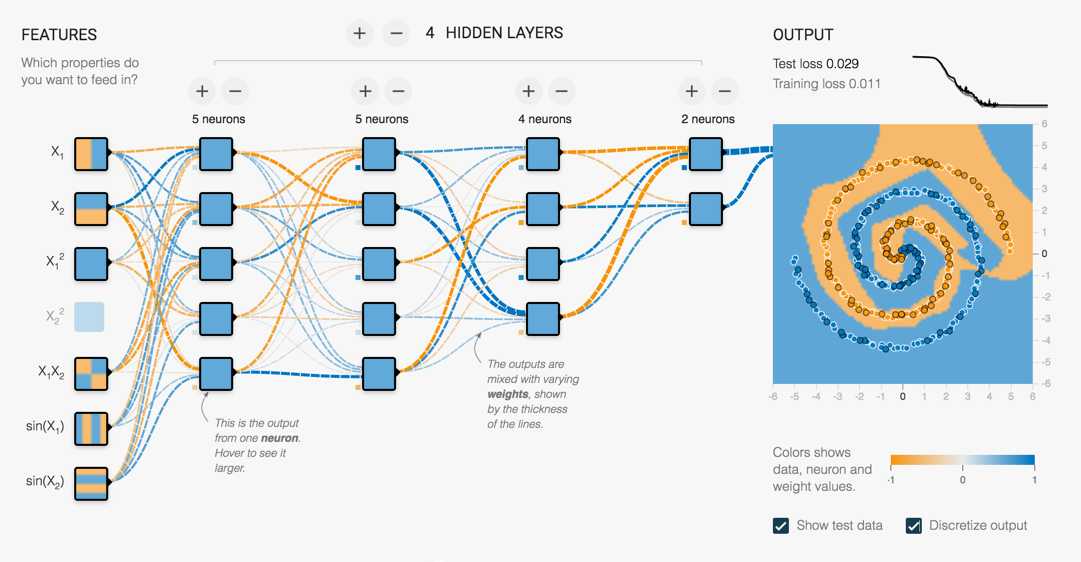Difference between revisions of "Tutorial: TensorFlow References"
(→Intro to Machine Learning and TensorFlow, Google video) |
(→Understanding Deep Neural Nets) |
||
| Line 7: | Line 7: | ||
==Understanding Deep Neural Nets== | ==Understanding Deep Neural Nets== | ||
[[Image:TensorFlowPlayGround.png|500px|right]] | [[Image:TensorFlowPlayGround.png|500px|right]] | ||
| − | * Start with this [http://blogs.scientificamerican.com/sa-visual/unveiling-the-hidden-layers-of-deep-learning/ article from Scientific American]: [http://blogs.scientificamerican.com/sa-visual/unveiling-the-hidden-layers-of-deep-learning/ Unveiling the Hidden Layers of Deep Learning, by Amanda Montanez, editor at Scientific American]. This short article references [http://www.scientificamerican.com/article/springtime-for-ai-the-rise-of-deep-learning/ Springtime for AI, the rise of deep-learning], published by Scientific American (you'll need a subscription to access this article.) | + | * '''Step 1''':Start with this [http://blogs.scientificamerican.com/sa-visual/unveiling-the-hidden-layers-of-deep-learning/ article from Scientific American]: [http://blogs.scientificamerican.com/sa-visual/unveiling-the-hidden-layers-of-deep-learning/ Unveiling the Hidden Layers of Deep Learning, by Amanda Montanez, editor at Scientific American]. This short article references [http://www.scientificamerican.com/article/springtime-for-ai-the-rise-of-deep-learning/ Springtime for AI, the rise of deep-learning], published by Scientific American (you'll need a subscription to access this article.) |
<br /> | <br /> | ||
| − | * '''Play | + | * '''Step 2''': ''Play'' with the [http://playground.tensorflow.org/#activation=relu&batchSize=21&dataset=spiral®Dataset=reg-plane&learningRate=0.03®ularizationRate=0&noise=10&networkShape=3,3,2&seed=0.56096&showTestData=true&discretize=true&percTrainData=70&x=false&y=true&xTimesY=true&xSquared=true&ySquared=false&cosX=false&sinX=true&cosY=false&sinY=true&collectStats=false&problem=classification&initZero=false TensorFlow playground], created by Daniel Smilkov and Shan Carter. |
<br /> | <br /> | ||
<br /> | <br /> | ||
| Line 18: | Line 18: | ||
<br /> | <br /> | ||
<br /> | <br /> | ||
| + | |||
==Machine-Learning Recipes== | ==Machine-Learning Recipes== | ||
<br /> | <br /> | ||
Revision as of 09:17, 8 August 2016
--D. Thiebaut (talk) 12:00, 6 August 2016 (EDT)
Contents
References & Tutorials
This page contains resources that will help you get up to speed with Machine Learning and TensorFlow. I have attempted to list the resources in a logical order, so that if you start from scratch, you will be presented by increasingly more sophisticated concepts as you progress. Note that all these tutorials assume a good understanding of Python an of how to install various packages for Python.
Understanding Deep Neural Nets
- Step 1:Start with this article from Scientific American: Unveiling the Hidden Layers of Deep Learning, by Amanda Montanez, editor at Scientific American. This short article references Springtime for AI, the rise of deep-learning, published by Scientific American (you'll need a subscription to access this article.)
- Step 2: Play with the TensorFlow playground, created by Daniel Smilkov and Shan Carter.
Machine-Learning Recipes
A very good (though quick) introduction to various Machine Learning concepts, presented by Josh Gordon. It is highly recommended to code all the examples presented.
Machine Learning Recipe #1: Hello world!
Machine Learning Recipe #2: Decision Trees
Machine Learning Recipe #3: What makes a good feature?
Machine Learning Recipe #4: Pipeline
Machine Learning Recipe #5: Writing your own classifier
Intro to Machine Learning and TensorFlow, Google video
This is a very good approach to TensorFlow which uses the wine quality data-set from UC Irvine Machine Learning repository. It uses the red wine data (winequality-red.csv). It starts with a 30-minute math tutorial presented by jenhsin0@gmail.com, and it covers
- entropy,
- variable dependency,
- dimensionality reduction,
- graph representation of models,
- activation functions in neural nets,
- loss functions, and
- gradient descent.
After a 10-minute pause (which is part of the video), the next speaker starts with a Jupyter notebook exploring various aspects of the wine-quality data. The notebook and associated data are available from this github repository.
WILDML: A Convolutional Neural Net for Text Classification in TF
- WildML Tutorial: A very detailed tutorial on text classification using TensorFlow.
